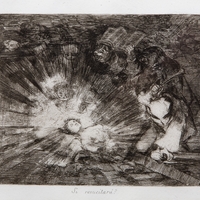-
Picture Rights
-
Courtesy of the Miami University Art Museum
-
Print Title
-
Si Resucitara?
-
Accession Number
-
1981.11
-
Artist
-
Goya Lucientes, Francisco José de, 1746-1828
-
Date Created
-
1906
-
Edition
-
Fourth
-
Print/Plate Number
-
80
-
Description
-
The print Si Rescuitara? is plate 80 in Goya 's Los Desastres de la Guerra print series. Si Rescuitara? shows a dark scene both in terms of tone and theme. The central figure of this print is a woman in a white dress laying on the ground. The woman is wreathed in a strong, bright light. That light radiates barely onto a crowd gathered around the woman. The woman has a calm, serene look on her face. Directly to the right of her, a sinister group of figures is gathered. To the far right, a man in a white robe, brandishing a club. To his left, a man in a dark robe brandishes a gun at the woman. To his immediate left, a strange figure wields a book above his head. This man appears to have the head of a dog or a walrus. His figure follows a strong tradition of strange creatures by Goya. Many of Goya’s prints show a variety of strange, horrifying, and fantastical creatures. In addition to this figure, a group of strange creatures hover in the far right background. These figures are mostly obscured by the dark lines of the print. This print does not employ the technique of aquatint to create the tones of the print. To the left of the walrus-headed figures, a second crowd of figures is gathered. The crowd of figures is standing in a position indicating mourning. They have their heads turned down, and their mouths look to be gagged. This group of people are standing as a solemn crowd, not intervening or acting on anything they are seeing. The plate belongs to the “caprichos” section of Desastres. This includes allegorical plates, which Si Resucitara? definitely belongs to. The plate could take on any amount of meanings, but a possible interpretation could be one of freedom. The woman could represent freedom, being stifled by any number of groups, including the Church, or the military, either French or Spanish. This print shows a reality of grappling with Goya’s works. Many of Goya’s works, whether they be prints or paintings, can take on multiple meanings and interpretations. Goya was not one to give detailed reasoning or artists statements for his prints, so many of them remain somewhat of a transfixing mystery.
-
Edition Provenance
-
The print was acquired by Miami University Art Museum in 1981, as a set of two donations by a donor named Robert Martin. Martin is a now-retired English professor at Miami University. Martin acquired the prints in the mid 1970s, and had them until 1981, where he donated them to the Miami University Art Museum. Martin bought the prints from Park West Galleries in Michigan. Martin attended auctions in Centerville; Dayton Ohio, and Cincinnati Ohio in the North Side. Martin bought multiple artworks from Park West, but only donated the Goya’s to the Miami University Art Museum. The prints came with a certificate of authenticity, so Martin knew they were real prints. By conducting an analysis of the paper, with the assistance of the Goya Prints Catalogue Raisone provided by the Cincinnati Art Museum, it was determined that the prints were fourth edition. The fourth edition prints were created in the Calcografia Nacional in Spain for the Real Academia in 1906. Unfortunately, there is a large gap between when the edition was printed, and when it came into possession of Park West Galleries. More research will need to be completed to determine when and how the prints arrived at Park West.
-
Condition
-
For shorthand, the print will be split into 9 sections, going from Top (T), Center (C) , Bottom (B), and Left (L), center (C) , Right (R) . There is cockling throughout the print. Small amounts of discoloration are present on the right side of the print. In addition, there is an indentation around the image, and markings, which are possibly the plate mark.
-
Holding Institution
-
Miami University (Oxford, Ohio; United States). Art Museum
-
Owned By
-
Miami University (Oxford, Ohio; United States). Art Museum (1981-Present)
-
Robert Martin (United States). (1971-1981)
-
Park West Galleries (Southfield, Michigan; United States) (Unknown -1971)
-
Calcografia Nacional (Madrid, Spain). (1906-Unknown)
 Si Resucitara?
Si Resucitara?